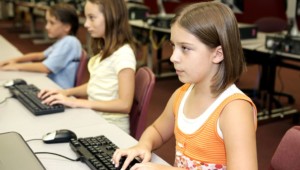Transforming the Way Students See Themselves

By Mari Jones
This Post was originally published on EdWeek.
“I hate my life.” Valeria had written these words on her art journal when tasked with designing the cover. This reflected her perception of school, her life, and herself when she entered my class two years ago. Truth be told, her life was hard. She had been living in a homeless shelter in second grade when she came to High Tech Elementary Explorer, a project-based, social-emotional charter school in San Diego. When she came to my class in fourth grade, she and her family had found a home, but she still had to take two buses and a trolley to get to school, and she struggled with depression and a learning disability. She was always sleepy, and never wanted to participate in the learning in our classroom. She often lay her head on the table saying, “I can’t do it.” She did not see herself as a learner. I knew that my work lay in helping her rewrite the narrative she had written for herself.
My interventions for Valeria came in the form of supports for her academic, as well as social-emotional, development. Mostly, I wanted to change her negative self-talk, and convince her that she was a learner whose work mattered to others. Regular exhibitions throughout the year gave Valeria the opportunity to share her learning with a larger audience of peers, family, and the community. Knowing she would publicly present her work provided the motivation to produce high quality work. Continuous reflection throughout the process allowed her to notice the ways in which she was growing as a learner and as a person. One of her artist statements revealed the beginnings of her transformation, “I think I have grown as an artist, because I know how to handle more responsibility.” In doing work that mattered, Valeria was beginning to see that she mattered too.
As Valeria’s negative self-talk began to subside, it was replaced by an enthusiasm for presenting her work to the public. For our Ideas that Change the World project, we had the opportunity to present our work as an exhibit at the San Diego History Center. They were commemorating the centennial of the World’s Fair in San Diego, and our World’s Fair exhibition fit in seamlessly. I could see Valeria’s growing confidence as she presented her invention to retirees visiting the center. Her invention, the R-Cart, was a robotic shopping cart that would aid blind shoppers. She fielded questions, demonstrated how it worked, and explained the invention process to her audience. “I wish I could have one now!” commented a guest. A far cry from the sullen girl who lay her head on the table, Valeria was bubbly and energetic, smiling and almost dancing as she shared her work.
Fast forward to the end of the year at her fifth grade presentation of learning. Valeria is standing confidently in front of a panel of her peers, family, and teacher, sharing her growth as a learner. She talks about the American Dream project, which she is most proud of, because it allowed her to face her fears and stand up in front of a live audience at the World Beat Center in Balboa Park, and perform her original spoken word poetry. She goes on to say that reading and writing have been challenging for her, but that she has been able to complete her work this year. As I look over at her mother and sister, I can see the pride in their eyes–they can tell that Valeria sees herself as a learner.
When students have the chance to do work that matters, and to present that work to people who matter to them, it makes students believe that they matter. Valeria did not transform overnight. But her story is the story of many of our kids, who need us to see them. Exhibiting her work to a real audience and sharing her reflections on her growth as a learner throughout the year allowed Valeria to shine.
Public presentations of learning have the power to transform the way students see themselves. Join the movement to transform education by committing to having your own students publicly present their learning. Sign up now here.
For more, see:
- How to Create & Cultivate a PBL Culture
- Building Student Ownership Through Community Mapping
- Competency-Based Education: Definitions and Difference Makers
Mari Jones is project co-director at the Center for Research on Equity and Innovation at the High Tech High Graduate School of Education.
Stay in-the-know with all things EdTech and innovations in learning by signing up to receive the weekly Smart Update.




0 Comments
Leave a Comment
Your email address will not be published. All fields are required.